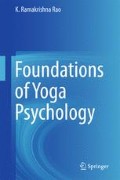Abstract
This chapter discusses different connotations of meditation and what it truly means. It goes on to review the various forms of meditation used in contemporary research against the backdrop of Buddhistic and Hindu traditions. Meditation is an important step in the eight-step practice of yoga. It is the seventh of the eight steps involved in yoga practice. It is meant essentially to control the natural wanderings of the mind. In Buddhist meditation, concentration as well as mindfulness is practiced. They help to achieve a higher state of awareness where the mind is unobsessed, and free from the compulsions of the ego and the delusion of permanence. Buddhaghoṣa’s Viśuddhimagga is an important source book of Buddhistic meditation in the Theravāda tradition. Meditative techniques used in empirical research include (a) focused/concentrative form of meditation, (b) transcendental meditation (TM), (c) Benson’s relaxation response, (d) mindfulness or passive meditation, and (e) vipassanā and Zen meditation.
Access this chapter
Tax calculation will be finalised at checkout
Purchases are for personal use only
References
Barber, T. X., DiCara, L., & Kamiya, J. (Eds.). (1972). Biofeedback and self-control. Chicago: Aldine.
Beary, J. F., & Benson, H. (1974). A simple psychophysiologic technique which elicits the hypometabolic changes on the relaxation response. Psychosomatic Medicine, 36, 115–120.
Benson, H. (1975). The relaxation response. New York: William Morrow.
Benson, H., Beary, J. F., & Carol, M. M. (1974). The relaxation response. Psychiatry, 37, 37–40.
Buddhaghoṣa. (1923). Visuddhimagga (The path of purity) (3 vols.). (M. Tim, Trans). London: Oxford University Press.
Cahn, B. R., & Polich, J. (2006). Meditation states and traits: EEG, ERP, and neuroimaging studies. Psychological Bulletin, 132(2), 180–211.
Carrington, P. (1977). Freedom in meditation. Garden City, NY: Doubleday.
Conze, E. (1954/1995). Buddhist texts through the ages. Oxford: One World.
Davidson, R., & Goleman, D. (1977). The role of attention in meditation and hypnosis: A psychological perspective on transformation of consciousness. International Journal of Clinical and Experimental Hypnosis, 25, 291–308.
Goleman, D. (1978). The varieties of the meditative experience. New York: Irvington publishers.
Jacobson, E. (1938). Progressive relaxation (2nd ed.). Chicago: University of Chicago Press.
Kabat-Zinn, J. (1994). Wherever you go, there you are. London: Piatkus.
Kabat-Zinn, J. (2003). Mindfulness-based stress reduction (MBSR). Constructivism Human Science, 8(2), 73–107.
Lutz, A., Dunne, J., & Davidson, R. J. (2007). Meditation and the neuroscience of consciousness: An introduction. In P. D. Zelazo, M. Moscovitch, & E. Thompson (Eds.), The Cambridge handbook of consciousness. New York and Cambridge: Cambridge University Press.
Naranjo, C., & Ornstein, R. E. (1971). On the psychology of meditation. New York: Viking Press.
Orme-Johnson, D. W., & Farrow, J. T. (Eds.). (1977). Scientific research on the transcendental meditation program: Collected papers (Vol. 1). Los Angeles: Maharishi European Research University Press.
Ospina, M. B., Bond, K., Karkhaneh, M., Tjosvold, L., Vandermeer, B., Liang, Y., et al. (2007). Meditation Practices for Health: State of the Research, prepared by the University of Alberta Evidence-based Practice Center for the Agency for Healthcare Research and Quality of the U.S. Department of Health and Human Services, Rockville, MD, pp. 208–50.
Rao, K. R. (1987). India’s heritage: A philosophical rendezvous [Sri Polisetty Seetharamanjaneyulu Lecture]. Nagarjuna Nagar: Nagarjuna University.
Schultz, J. H., & Luth, W. (1959). Autogenic training. New York: Grune and Stratton.
Schwartz, G. E., Davidson, R. J., & Goleman, D. J. (1978). Patterning of cognitive and somatic processes in the self-regulation of anxiety: Effects of meditation versus exercise. Psychosomatic Medicine, 40, 321–328.
Segal, Z. V., Williams, J. M. G., & Teasdale, J. D. (2002). Mindfulness-based cognitive therapy for depression. New York: Guildford Press.
Sinha, J. L. (1961). Indian psychology, (Vol. 2)—Emotion and will. New Delhi: Motilal Banarasidass.
Smith, J. C. (1986). Meditation: A sensible guide to a timeless discipline. Champaign, IL: Research Press.
Sogen, O. (2001). An introduction to Zen training: A translation of Sanzen Nyumm. Boston: Tuttle Publishing.
Wallace, R. K. (1970). Physiological effects of transcendental meditation. Science, 167, 1751–1754.
Wallace, R. K., & Benson, H. (1972). The physiology of meditation. Scientific American, 226, 84–90.
Yogi, M. (1963a). The science of being and art of living. London: Unwin.
Yogi, M. (1963b). Transcendental meditation. New York: New American Library.
Author information
Authors and Affiliations
Corresponding author
Rights and permissions
Copyright information
© 2017 The Author(s)
About this chapter
Cite this chapter
Rao, K. (2017). What Is Meditation?. In: Foundations of Yoga Psychology. Springer, Singapore. https://doi.org/10.1007/978-981-10-5409-9_5
Download citation
DOI: https://doi.org/10.1007/978-981-10-5409-9_5
Published:
Publisher Name: Springer, Singapore
Print ISBN: 978-981-10-5408-2
Online ISBN: 978-981-10-5409-9
eBook Packages: Behavioral Science and PsychologyBehavioral Science and Psychology (R0)

